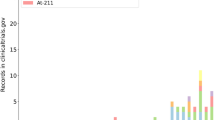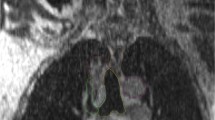Abstract
Purpose
The tangential-beam technique frequently presents challenges in homogeneity of radiation dose to the target. To ensure an adequate dose to the skin, a bolus is often used. Tomotherapy has already been shown to improve target conformity and homogeneity in other disease sites. Because of the tangential delivery technique and lack of flattening filter in TomoTherapy accelerators, we hypothesize that during chest wall irradiation using tomotherapy, the skin dose will be adequate without bolus.
Materials and methods
This study compares the dosimetric differences between tomotherapy chest wall irradiation and traditional linear accelerator-based tangential-beam technique. Tomotherapy treatment plans with and without bolus were compared with tangentialbeam plans. Plans were also generated for phantom studies, and point doses were measured using MOSFET dosimetry to verify the adequate skin dose. Monte Carlo simulations of static beams of both techniques were performed, and dosimetry was compared.
Results
Monte Carlo simulations and measurements confirmed that beams from tomotherapy deliver a higher skin dose than a standard linear accelerator. Skin dose also increases with the incident angle of the beams.
Conclusion
Because of the characteristics of the tomotherapy beam and delivery technique, chest wall treatment plans from tomotherapy showed adequate skin dose [more than 75% of prescribed planning target volume (PTV) dose] even without bolus.
Similar content being viewed by others
References
Aref A, Thornton D, Youssef E, He T, Tekyi-Mensah S, Denton L, Ezzell G. Dosimetric improvements following 3D planning of tangential breast irradiation. Int J Radiat Oncol Biol Phys 2000;48:1569–1574.
Hansen VN, Evans PM, Shentall GS, Helyer SJ, Yarnold JR, Swindell W. Dosimetric evaluation of compensation in radiotherapy of the breast: MLC intensity modulation and physical compensators. Radiother Oncol 1997;42:249–256.
Hong L, Hunt M, Chui C, Spirou S, Forster K, Lee H, et al. Intensity-modulated tangential beam irradiation of the intact breast. Int J Radiat Oncol Biol Phys 1999;44:1155–1164.
Chao KSC, Perez CA, Brady LW. Breast: locally advanced (T3 and T4), inflammatory, and recurrent tumors. In: Chao KSC, Perez CA, Brady LW, editors. Radiation oncology management decisions. Philadelphia: Lippincott Williams & Wilkins; 2002. p. 367–375.
Ragaz J, Jackson SM, Le N, Plenderleith IH, Spinelli JJ, Basco VE, et al. Adjuvant radiotherapy and chemotherapy in node-positive premenopausal women with breast cancer. N Engl J Med 1997;337:956–962.
McCormick BM, Hudis C, Gemignani M, Dershaw DD, Tan LK, Perez CA, et al. Breast cancer. In: Hoskins WJ, Perez CA, Young RC, Barakat RR, Markman M, editors. Principles and practice of gynecologic oncology. Philadelphia: Lippincott Williams & Wilkins; 2004. p. 1077–1170.
Wells M, Macmillan M, Raab G, MacBride S, Bell N, MacKinnon K, et al. Does aqueous or sucralfate cream affect the severity of erythematous radiation skin reactions? A randomised controlled trial. Radiother Oncol 2004;73:153–162.
Quach KY, Morales J, Butson MJ, Rosenfeld AB, Metcalfe PE. Measurement of radiotherapy x-ray skin dose on a chest wall phantom. Med Phys 2000;27:1676–1680.
Kron T, Grigorov G, Yu E, Yartsev S, Chen JZ, Wong E, et al. Planning evaluation of radiotherapy for complex lung cancer cases using helical tomotherapy. Phys Med Biol 2004;49:3675–3690.
Sheng K, Molloy JA, Larner JM, Read PW. A dosimetric comparison of non-coplanar IMRT versus helical tomotherapy for nasal cavity and paranasal sinus cancer. Radiother Oncol 2007;82:174–178.
Tournel K, Verellen D, Duchateau M, Fierens Y, Linthout N, Reynders T, et al. An assessment of the use of skin flashes in helical tomotherapy using phantom and in-vivo dosimetry. Radiother Oncol 2007;84:34–39.
Cheek D, Gibbons JP, Rosen II, Hogstrom KR. Accuracy of TomoTherapy treatments for superficial target volumes. Med Phys 2008;35:3565–3573.
Ramsey CR, Seibert RM, Robison B, Mitchell M. Helical tomotherapy superficial dose measurements. Med Phys 2007; 34:3286–3293.
Hardcastle N, Soisson E, Metcalfe P, Rosenfeld AB, Tome WA. Dosimetric verification of helical tomotherapy for total scalp irradiation. Med Phys 2008;35:5061–5068.
ICRU. The biological basis for dose limitation in the skin. Oxford: Pergamon; 1992.
Chow JCL, Grigorov GN. Surface dosimetry for oblique tangential photon beams: a Monte Carlo simulation study. Med Phys 2008;35:70–76.
Lu W, Olivera GH, Chen M-L, Reckwerdt PJ, Mackie TR. Accurate convolution/superposition for multi-resolution dose calculation using cumulative tabulated kernels. Phys Med Biol 2005;50:655–680.
Evans PM, Donovan EM, Partridge M, Childs PJ, Convery DJ, Eagle S, et al. The delivery of intensity modulated radiotherapy to the breast using multiple static fields. Radiother Oncol 2000;57:79–89.
Battista JJ, Sharpe MB. True three-dimensional dose computations for megavoltage x-ray therapy: a role for the superposition principle. Australas Phys Eng Sci Med 1992;15:159–178.
Kawrakow I. Accurate condensed history Monte Carlo simulation of electron transport. I. EGSnrc, the new EGS4 version. Med Phys 2000;27:485–498.
Rogers DWO, Faddegon BA, Ding GX, Ma C-M, We J, Mackie TR. BEAM: a Monte Carlo code to simulate radiotherapy treatment units. Med Phys 1995;22:503–524.
Ma C-M, Reckwerdt P, Holmes M, Rogers DWO, Geiser B. DOSxyz users manual NRC report. National Research Council Canada 1995.
Fenwick JD, Tome WA, Jaradat HA, Hui SK, James JA, Balog JP, et al. Quality assurance of a helical tomotherapy machine. Phys Med Biol 2004;49:2933–2953.
Xiang HF, Song JS, Chin DWH, Cormack RA, Tishler RB, Makrigiorgos GM, et al. Build-up and surface dose measurements on phantoms using micro-MOSFET in 6 and 10 MV x-ray beams and comparisons with Monte Carlo calculations. Med Phys 2007;34:1266–73.
Author information
Authors and Affiliations
Corresponding author
About this article
Cite this article
Javedan, K., Zhang, G., Mueller, R. et al. Skin dose study of chest wall treatment with tomotherapy. Jpn J Radiol 27, 355–362 (2009). https://doi.org/10.1007/s11604-009-0357-9
Received:
Accepted:
Published:
Issue Date:
DOI: https://doi.org/10.1007/s11604-009-0357-9




